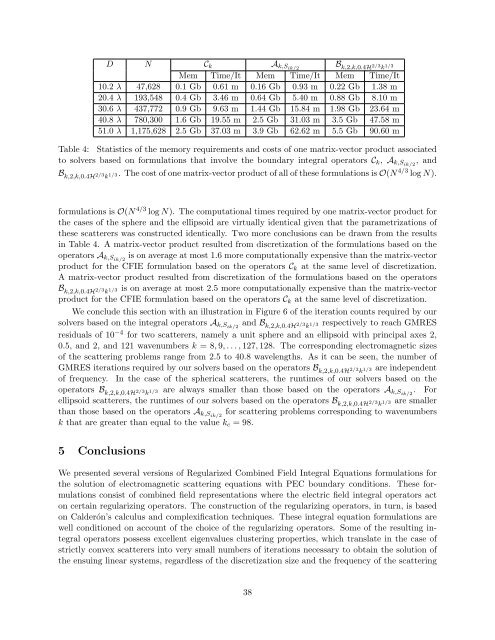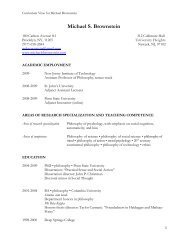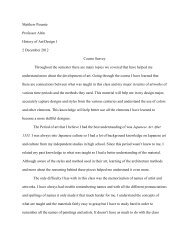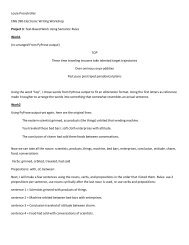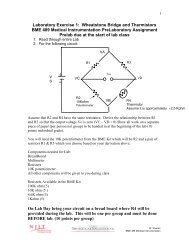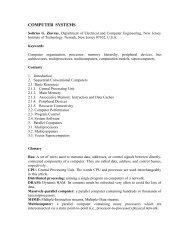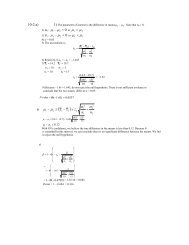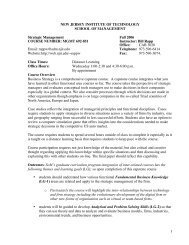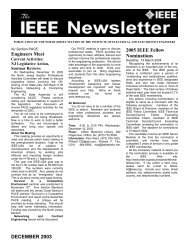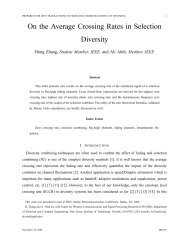Well-conditioned boundary integral formulations for the ... - Njit
Well-conditioned boundary integral formulations for the ... - Njit
Well-conditioned boundary integral formulations for the ... - Njit
Create successful ePaper yourself
Turn your PDF publications into a flip-book with our unique Google optimized e-Paper software.
D N C k A k,Sik/2 B k,2,k,0.4H 2/3 k 1/3<br />
Mem Time/It Mem Time/It Mem Time/It<br />
10.2 λ 47,628 0.1 Gb 0.61 m 0.16 Gb 0.93 m 0.22 Gb 1.38 m<br />
20.4 λ 193,548 0.4 Gb 3.46 m 0.64 Gb 5.40 m 0.88 Gb 8.10 m<br />
30.6 λ 437,772 0.9 Gb 9.63 m 1.44 Gb 15.84 m 1.98 Gb 23.64 m<br />
40.8 λ 780,300 1.6 Gb 19.55 m 2.5 Gb 31.03 m 3.5 Gb 47.58 m<br />
51.0 λ 1,175,628 2.5 Gb 37.03 m 3.9 Gb 62.62 m 5.5 Gb 90.60 m<br />
Table 4: Statistics of <strong>the</strong> memory requirements and costs of one matrix-vector product associated<br />
to solvers based on <strong><strong>for</strong>mulations</strong> that involve <strong>the</strong> <strong>boundary</strong> <strong>integral</strong> operators C k , A k,Sik/2 , and<br />
B k,2,k,0.4H 2/3 k 1/3. The cost of one matrix-vector product of all of <strong>the</strong>se <strong><strong>for</strong>mulations</strong> is O(N 4/3 log N).<br />
<strong><strong>for</strong>mulations</strong> is O(N 4/3 log N). The computational times required by one matrix-vector product <strong>for</strong><br />
<strong>the</strong> cases of <strong>the</strong> sphere and <strong>the</strong> ellipsoid are virtually identical given that <strong>the</strong> parametrizations of<br />
<strong>the</strong>se scatterers was constructed identically. Two more conclusions can be drawn from <strong>the</strong> results<br />
in Table 4. A matrix-vector product resulted from discretization of <strong>the</strong> <strong><strong>for</strong>mulations</strong> based on <strong>the</strong><br />
operators A k,Sik/2 is on average at most 1.6 more computationally expensive than <strong>the</strong> matrix-vector<br />
product <strong>for</strong> <strong>the</strong> CFIE <strong>for</strong>mulation based on <strong>the</strong> operators C k at <strong>the</strong> same level of discretization.<br />
A matrix-vector product resulted from discretization of <strong>the</strong> <strong><strong>for</strong>mulations</strong> based on <strong>the</strong> operators<br />
B k,2,k,0.4H 2/3 k 1/3 is on average at most 2.5 more computationally expensive than <strong>the</strong> matrix-vector<br />
product <strong>for</strong> <strong>the</strong> CFIE <strong>for</strong>mulation based on <strong>the</strong> operators C k at <strong>the</strong> same level of discretization.<br />
We conclude this section with an illustration in Figure 6 of <strong>the</strong> iteration counts required by our<br />
solvers based on <strong>the</strong> <strong>integral</strong> operators A k,Sik/2 and B k,2,k,0.4H 2/3 k1/3 respectively to reach GMRES<br />
residuals of 10 −4 <strong>for</strong> two scatterers, namely a unit sphere and an ellipsoid with principal axes 2,<br />
0.5, and 2, and 121 wavenumbers k = 8, 9, . . . , 127, 128. The corresponding electromagnetic sizes<br />
of <strong>the</strong> scattering problems range from 2.5 to 40.8 wavelengths. As it can be seen, <strong>the</strong> number of<br />
GMRES iterations required by our solvers based on <strong>the</strong> operators B k,2,k,0.4H 2/3 k1/3 are independent<br />
of frequency. In <strong>the</strong> case of <strong>the</strong> spherical scatterers, <strong>the</strong> runtimes of our solvers based on <strong>the</strong><br />
operators B k,2,k,0.4H 2/3 k 1/3 are always smaller than those based on <strong>the</strong> operators A k,S ik/2<br />
. For<br />
ellipsoid scatterers, <strong>the</strong> runtimes of our solvers based on <strong>the</strong> operators B k,2,k,0.4H 2/3 k 1/3 are smaller<br />
than those based on <strong>the</strong> operators A k,Sik/2 <strong>for</strong> scattering problems corresponding to wavenumbers<br />
k that are greater than equal to <strong>the</strong> value k c = 98.<br />
5 Conclusions<br />
We presented several versions of Regularized Combined Field Integral Equations <strong><strong>for</strong>mulations</strong> <strong>for</strong><br />
<strong>the</strong> solution of electromagnetic scattering equations with PEC <strong>boundary</strong> conditions. These <strong><strong>for</strong>mulations</strong><br />
consist of combined field representations where <strong>the</strong> electric field <strong>integral</strong> operators act<br />
on certain regularizing operators. The construction of <strong>the</strong> regularizing operators, in turn, is based<br />
on Calderón’s calculus and complexification techniques. These <strong>integral</strong> equation <strong><strong>for</strong>mulations</strong> are<br />
well <strong>conditioned</strong> on account of <strong>the</strong> choice of <strong>the</strong> regularizing operators. Some of <strong>the</strong> resulting <strong>integral</strong><br />
operators possess excellent eigenvalues clustering properties, which translate in <strong>the</strong> case of<br />
strictly convex scatterers into very small numbers of iterations necessary to obtain <strong>the</strong> solution of<br />
<strong>the</strong> ensuing linear systems, regardless of <strong>the</strong> discretization size and <strong>the</strong> frequency of <strong>the</strong> scattering<br />
38


